Mises, Ludwig von. Human Action: A Treatise on Economics
Подождите немного. Документ загружается.

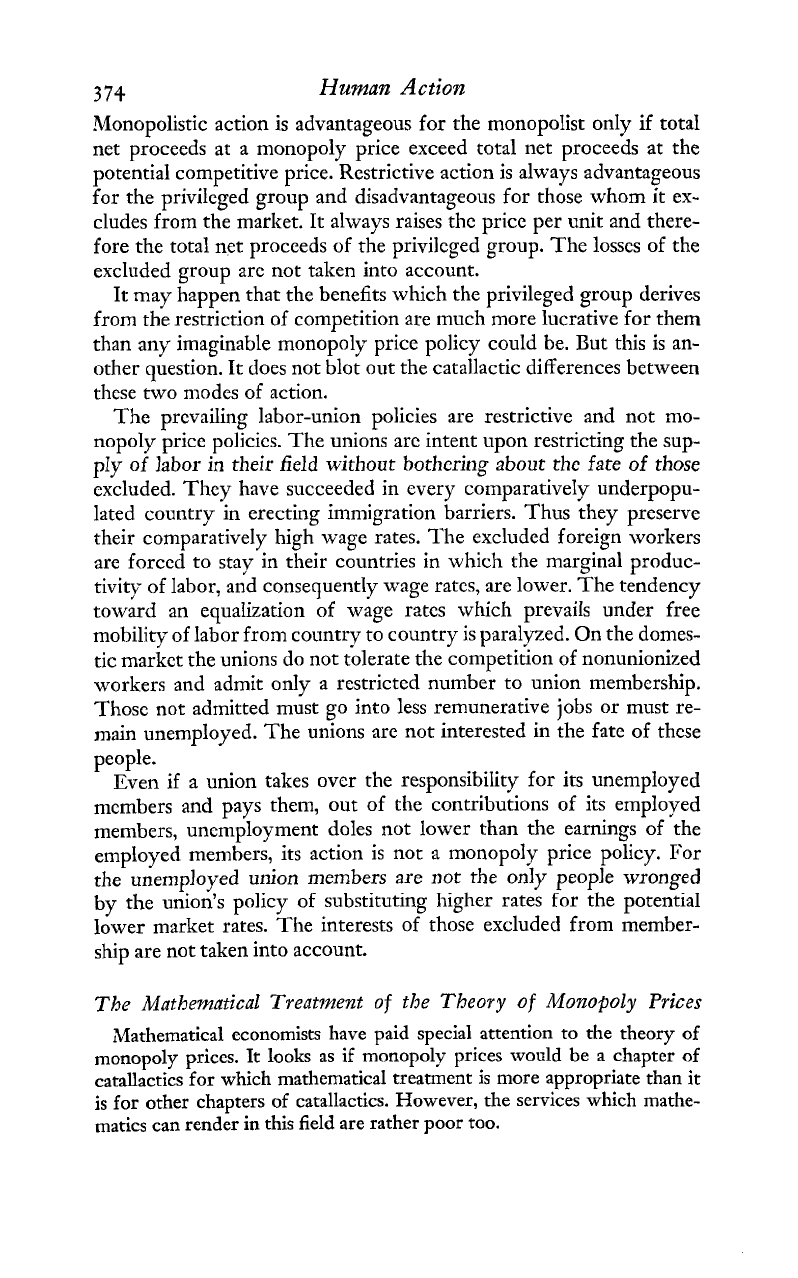
3
74
Human
Action
.Monopolistic action is advantageous for the monopolist only if total
net proceeds at a monopoly price exceed total net proceeds at the
potential competitive price. Restrictive action is always advantageous
for the privileged group and disadvantageous for those whom it ex-
cludes from the market. It always raises the price per unit and there-
fore the total net proceeds of the
privileged
group. The losses of the
excluded group are not taken into account.
It may happen that the benefits which the privileged group derives
from the restriction of competition are much more lucrative for them
than any imaginable monopoly price policy could be. But this is an-
other question. It does not blot out the catallactic differences between
these two modes of action.
The prevailing labor-union policies are restrictive and not n~o-
nopoly price policics. The unions are intent upon restricting the sup-
ply of labor in their
field
without
bothering
about
the fare
of
those
cxcluded. They have succeeded in cvery comparativeIy underpopu-
lated country in erecting immigration barriers. Thus they preserve
their comparatively high wage rates. The excluded foreign workers
are forced to stay in their countries in which the marginal produc-
tivity of labor, and consequently wage rates, are lower. The tendency
toward an equalization of wage rates which prevails under free
mobility of labor from country to country is paralyzed.
On
the domes-
tic market the unions do not tolerate the competition of nonunionized
workers and admit only a restricted number to union membership.
Those not admitted must go into less remunerative jobs or must re-
main unemployed. The unions are not interested in the fate of thcse
people.
Even if a union takes ovcr the responsibility for its unemployed
mcmbers and pays them, out of the contributions of its employed
members, unemployment doles not lower than the earnings of the
employed members, its action is not
a
monopoly price policy. For
the unemployed union members
are
not
the
only people wronged
by the union's policy of substituting higher rates for the potential
lower market rates. The interests of those excluded from member-
ship are not taken into account.
The Mathematical Treatment of the Theory of Monopoly Prices
Mathematical economists have paid special attention to the theory of
monopoly prices. It looks
as
if monopoly prices would be
a
chapter of
catallactics for which mathematical treatment is more appropriate than it
is
for other chapters of catallactics. However, the services which mathe-
matics can render
in
this field are rather poor too.
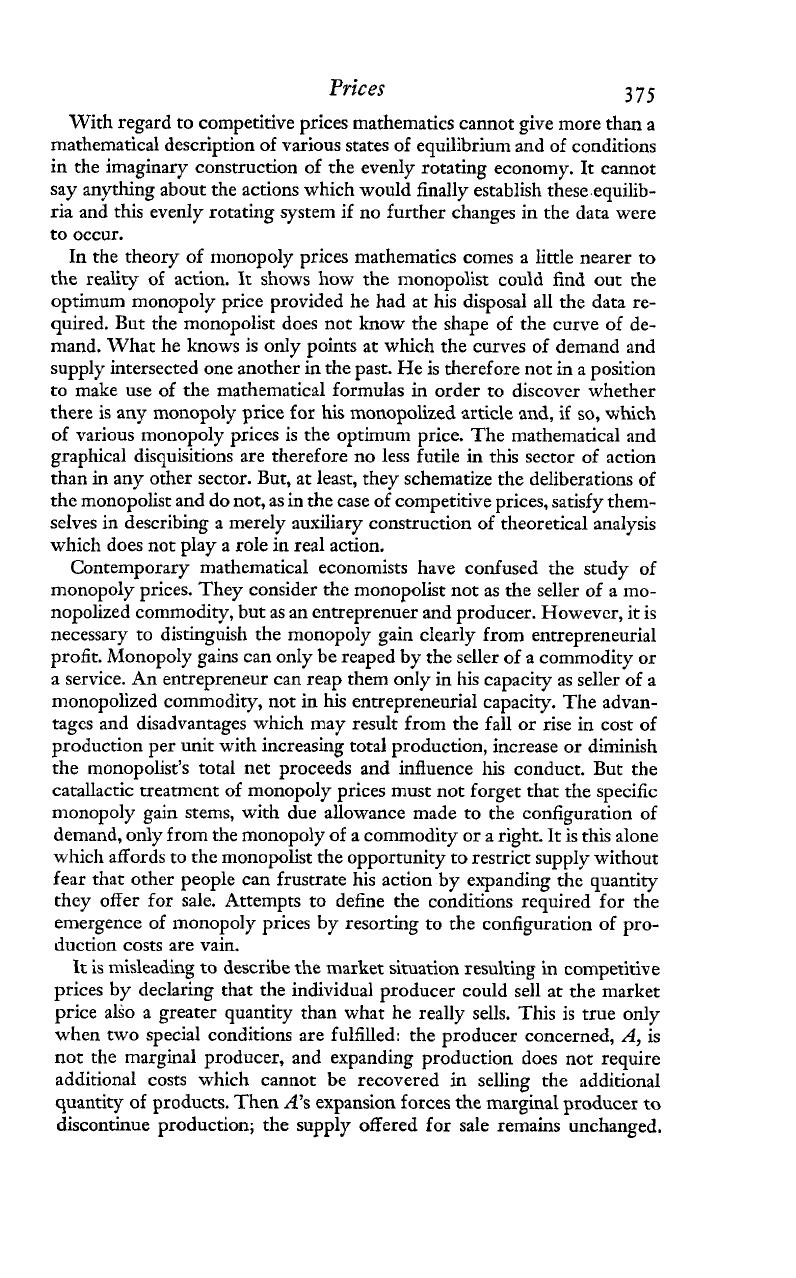
Prices
375
With regard to competitive prices mathematics cannot give more than
a
mathematical description of various states of equilibrium and of conditions
in the imaginary construction of the evenly rotating economy. It cannot
say anything about the actions which would finally establish these equilib-
ria and this evenly rotating system if no further changes in the data were
to occur.
In the theory of monopoly prices mathematics comes a little nearer to
the reality of action. It shows how the monopolist could find out the
optimum monopoly price provided he had at his disposal all the data re-
quired. But the monopolist does not know the shape of the curve of de-
mand. What he knows is only points at which the curves of demand and
supply intersected one another in the past. He is therefore not in
a
position
to make use of the mathematical formulas in order to discover whether
there is any monopoly price for
his
monopolized article and, if so,
which
of various monopoly prices is the optimum price. The mathemaucal and
graphical disquisitions are therefore no less futile in this sector of action
than in any other sector. But, at least, they schematize the deliberations of
the monopolist and do not, as in the case of competitive prices, satisfy them-
selves in describing a merely auxiliary construction of theoretical analysis
which does not play a role in real action.
Contemporary mathematical economists have confused the study of
monopoly prices. They consider the monopolist not
as
the seller of a mo-
nopolized commodity, but as an entreprenuer and producer. However, it is
necessary to distinguish the monopoly gain clearly from entrepreneurial
profit. Monopoly gains can only be reaped by the seller of a commodity or
a service. An entrepreneur can reap them only in his capacity as seller of a
nlonopolized commodity, not in his entrepreneurial capacity. The advan-
tages and disadvantages which may result from the fall or rise in cost of
production per unit with increasing total production, increase or diminish
the monopolist's total net proceeds and influence his conduct. But the
catallactic treatment of monopoly prices must not forget that the specific
monopoly gain stems, with due allowance made to the configuration of
demand, only from the monopoly of a commodity or
a
right. It is this alone
which affords to the monopolist the opportunity to restrict supply without
fear that other people can frustrate his action by expanding the quantity
they offer for sale. Attempts to define the conditions required for the
emergence of monopoly prices by resorting to the configuration of pro-
duction costs are vain.
It
is
misleading to describe the market situation resulting in competitive
prices by declaring that the individual producer could sell at the market
price also a greater quantity than what he really sells. This is true only
when two special conditions are fulfilled: the producer concerned,
A,
is
not the marginal producer, and expanding production does not require
additional costs which cannot be recovered in selling the additional
quantity of products. Then
A's
expansion forces the marginal producer to
discontinue production; the supply offered for sale remains unchanged.
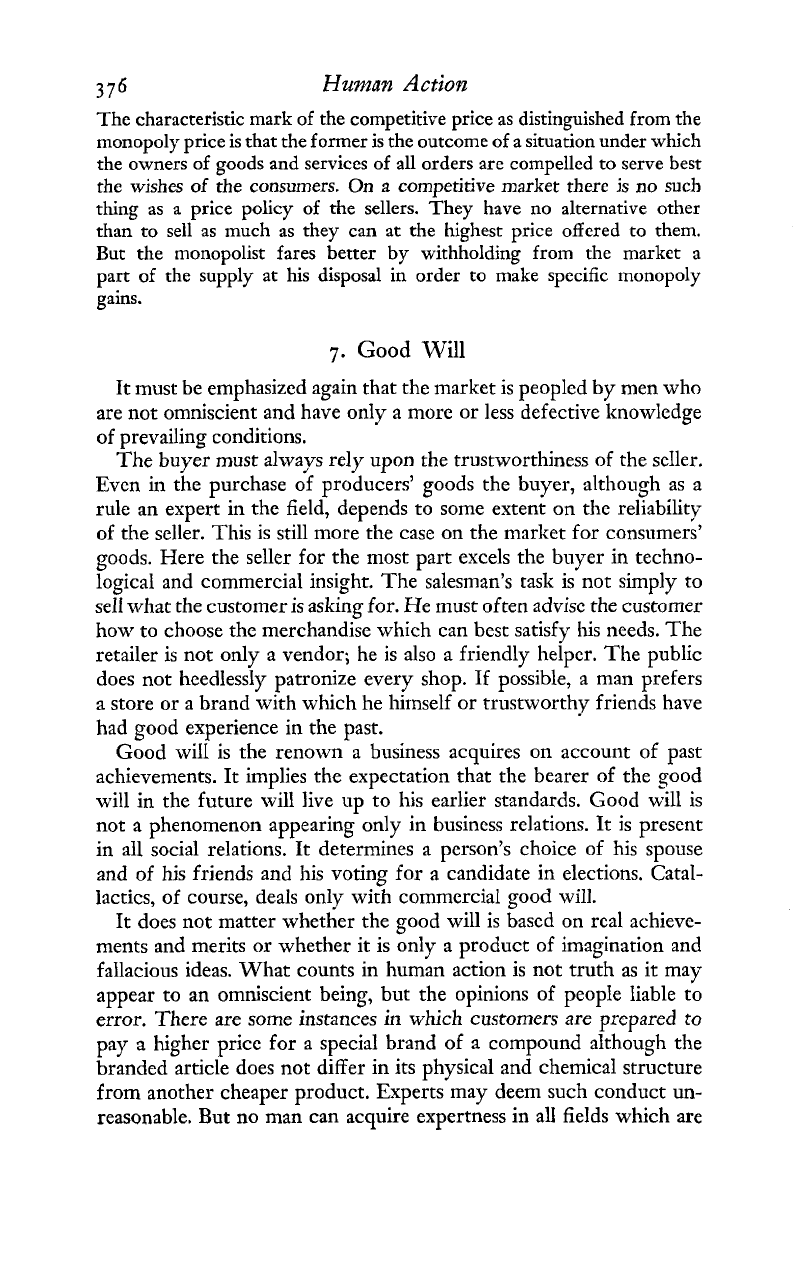
376
Hzlnzan
Action
The characteristic mark of the competitive price
as
distinguished from the
monopoly price is that the former is the outcome of
a
situation under which
the owners of goods and services of all orders are compelled to serve best
the wishes of the consumers.
On
a
competitive market there
s
no such
thing as
a
price policy of the sellers. They have no alternative other
than to sell
as
much
as
they can
at
the highest price offered to them.
But
the monopolist fares better by withholding from the market
a
part of the supply at his disposal in order to make specific monopoly
gains.
7.
Good
Will
It must be emphasized again that the market is peopled by men who
are not omniscient and have only a more or less defective knowledge
of prevailing conditions.
The buyer must always rely upon the trustworthiness of the seIler.
Even in the purchase of producers' goods the buyer, although as a
rule an expert in the field, depends to some extent on the reliability
of
the seller. This is still more the case on the market for consumers'
goods. Here the seller for the most part excels the buyer in techno-
logical and commercial insight. The salesman's task is not simply to
sell what the customer is asking for. He must often advise the customer
how to choose the merchandise which can best satisfy his needs. The
retailer is not only a vendor; he is also a friendly helper. The public
does not heedlessly patronize every shop. If possible, a man prefers
a store or a brand with which he hirnself or trustworthy friends have
had good experience in the past.
Good
wilI
is the renown a business acquires on account of past
achievements. It implies the expectation that the bearer of the good
will in the future
will
live up to his earlier standards. Good will is
not
a
phenomenon appearing only in business relations. It is present
in all social relations. It determines a person's choice of his spouse
and of his friends and his voting for
a
candidate in elections. Catal-
lactics, of course, deals only with commercial good will.
It does not matter whether the good will is based on real achieve-
ments and merits or whether it is only a product of imagination and
fallacious ideas. What counts in human action is not truth as it may
appear to an omniscient being, but the opinions of peopIe liable to
error. There are some instances in which customers
are
prepared
to
pay
a
higher price for a special brand of a compound although the
branded article does not differ in its physical and chemical structure
from another cheaper product. Experts may deem such conduct un-
reasonable.
But
no man can acquire expertness in all fields which are
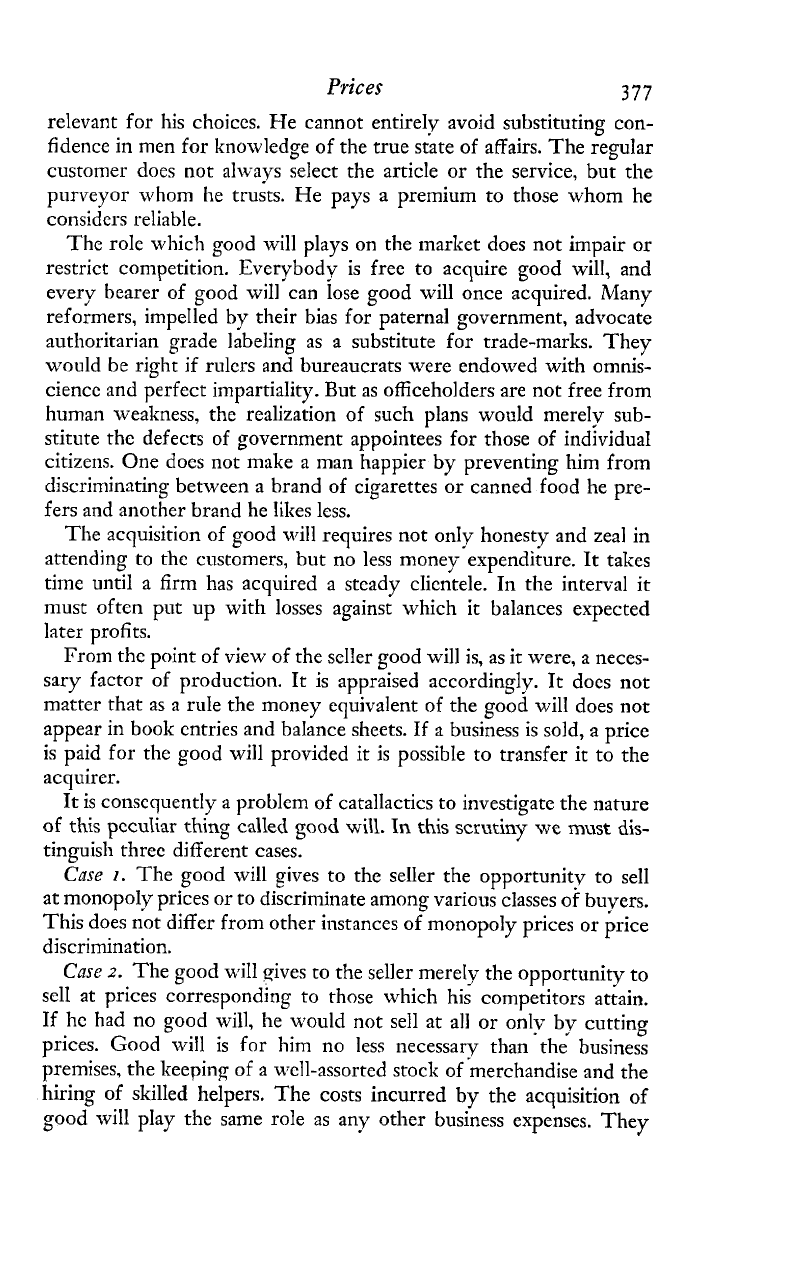
Prices
377
relevant for his choices. He cannot entirely avoid substituting con-
fidence in men for knowledge of the true state
of
affairs. The regular
customer does not always select the article or the service, but the
purveyor whom he trusts. He pays a premium to those whom he
considers reliable.
The role which good will plays on the marltet does not impair or
restrict competition. Everybody is free to acquire good will, and
every bearer of good will can lose good will once acquired. Many
reformers, impelled by their bias for paternal government, advocate
authoritarian grade labeling as a substitute for trade-marks. They
would be right if rulers and bureaucrats were endowed with omnis-
cience and perfect impartiality. But as officeholders are not free from
human weakness, the realization of such plans would merely sub-
stitute the defects of government appointees for those of individual
citizens. One does not make a man happier by preventing him from
discriminating between a brand of cigarettes or canned food he pre-
fers and another brand he likes less.
The acquisition of good will requires not on1~ honesty and zeal in
attending to the customers, but no less moneyeexpenditure.
It
takcs
time until a firm has acquired a stcady clientele. In the interval it
must oftcn put up with losses against which it balances expected
later profits.
From the point of view of the seller good will is, as it were, a neces-
sary factor of production.
It
is appraised accordingly. It does not
mattcr that as a rule the money equivalent of the good will does not
appear in book cntries and balance sheets. If a business is sold, a price
is paid for the good will provided it is possible to transfer it to the
acquirer.
It is consequently a problem of catallactics to investigate the nature
of this pcculiar
thing
called
good
will.
In
this
scrutiny
we
must
dis-
tinpish three different cases.
Case
I.
The good will gives to the seller the opportunitv to sell
at monopoly prices or to discriminate among various classes of buyers.
This does not differ from other instances of monopoly prices or price
discrimination.
Case
2.
The good will eives to the seller merely the opportunitv to
sell at prices corresponding to those which his competitors attain.
If he had no good will, he would not sell at all or onlv by cutting
prices. Good will is for him no less necessary than the business
premises, the keeping of a well-assorted stock of merchandise and the
hiring of skilled helpers. The costs incurred
by
the acquisition of
good will play the same role as any other business expenses. They
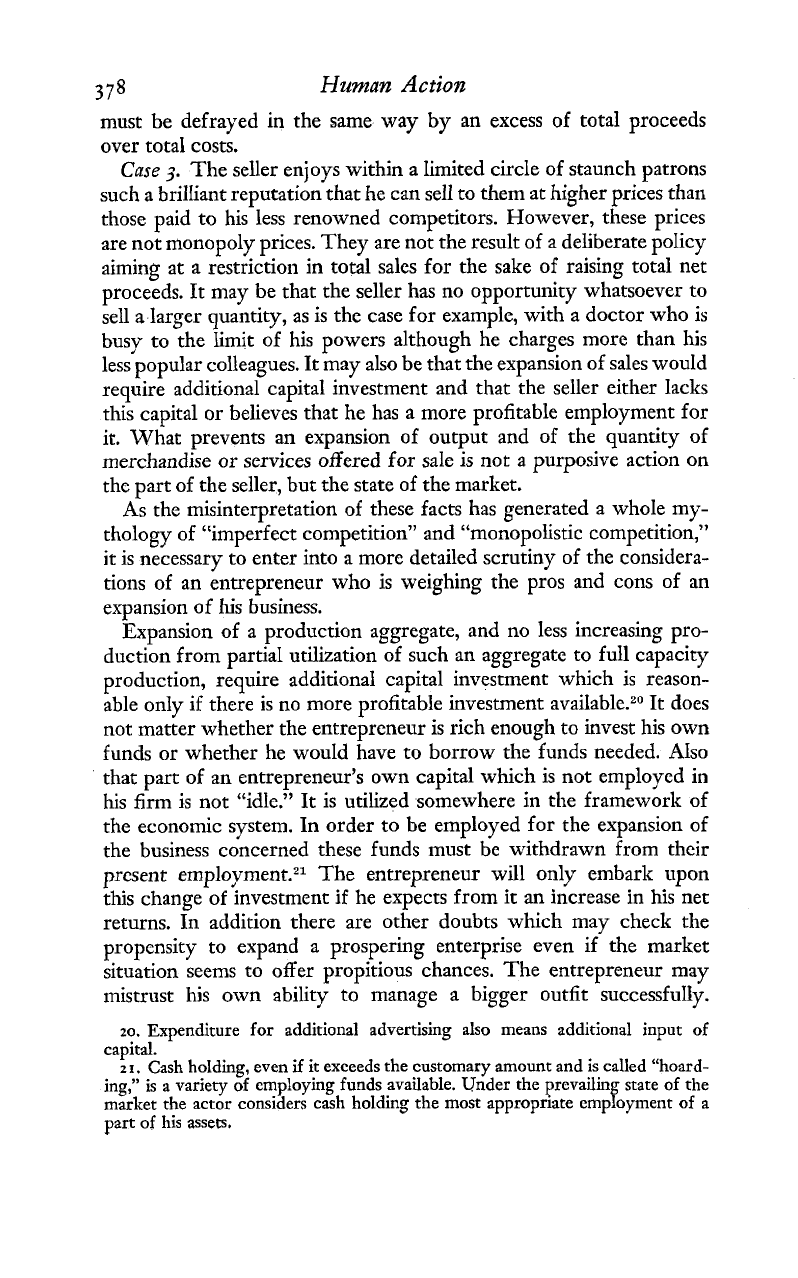
378
Human
Action
must be defrayed in the same way by an excess of total proceeds
over total costs.
Case
3.
The seller enjoys within a limited circle of staunch patrons
such
a
brilliant reputation that he can sell to them at higher prices than
those paid to his less renowned competitors. However, these prices
are not monopoly prices. They are not the result of a deliberate policy
aiming at a restriction in total sales for the sake of raising total net
proceeds. It may be that the seller has no opportunity whatsoever to
sell a larger quantity, as is the case for example, with a doctor who is
busy to the limit of his powers although he charges more than his
less popular colleagues. It may also be that the expansion of sales would
require additional capital investment and that the seller either lacks
this capital or believes that he has a more profitable employment for
it. What prevents an expansion of output and of the quantity of
merchandise or services offered for sale is not
a
purposive action on
the part of the seller, but the state of the market.
As the misinterpretation of these facts has generated a whole my-
thology of "imperfect competition" and "monopolistic competition,"
it
is necessary to enter into a more detailed scrutiny of the considera-
tions of an entrepreneur who is weighing the pros and cons of an
expansion of his business.
Expansion of
a
production aggregate, and no less increasing pro-
duction from partial utilization of such an aggregate to full capacity
production, require additional capital investment which is reason-
able only if there is no more profitable investment It does
not matter whether the entrepreneur is rich enough to invest his own
funds or whether he would have to borrow the funds needed. AIso
that part of an entrepreneur's own capital which is not employed
in
his firm is not "idle." It is utilized somewhere in the framework of
the economic system. In order to be employed for the expansion of
the business concerned these funds must be withdrawn from their
present ernpl~yrnent.~~ The entrepreneur will only embark upon
this change of investment if he expects from it
an
increase in his net
returns. In addition there are other doubts which may check the
propensity to expand a prospering enterprise even if the market
situation seems to offer propitious chances. The entrepreneur
may
mistrust his own ability to manage a bigger outfit successfuIly.
zo. Expenditure for additional advertising also means additional input of
capital.
z
I.
Cash holding, even
if
it exceeds the customary amount and is called "hoard-
ing,"
is
a variety of employing funds available. Under the prcvailin state of the
part
of
his
assets.
B
market the actor considers cash holding the most appropriate cmp oyment of a
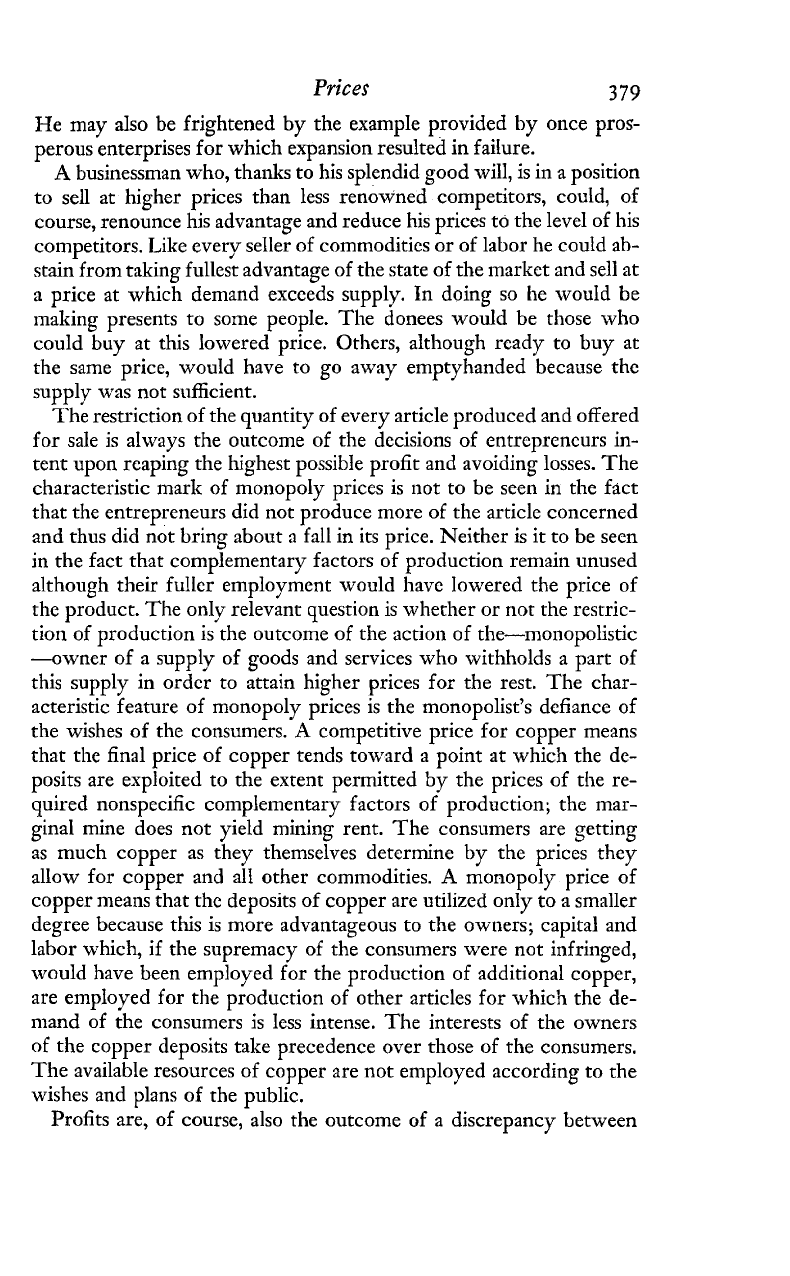
Prices
379
He may also be frightened by the example provided by once pros-
perous enterprises for which expansion resulted in failure.
A
businessman who, thanks to his splendid good will, is in a position
to sell at higher prices than less renowned competitors, could, of
course, renounce his advantage and reduce his prices to thc level of his
competitors. Like every seller of commodities or of labor he couId ab-
stain from taking fullest advantage of the state of the market and sell at
a price at which demand exceeds supply. In doing so he would be
making presents to some people. The donees would be those who
could buy at this lowered price. Others, although ready to buy at
the same price, would have to go away emptyhanded because the
supply was not sufficient.
The restriction of the quantity of every article produced and offered
for sale is always the outcome of the decisions of entreprencurs in-
tent upon reap& the highest possible profit and avoiding losses. The
characteristic mark of monopoly prices is not to be seen in the fact
that the entrepreneurs did not produce more of the article concerned
and thus did not bring about
a
fall in its price. Neither is it to be secn
in the fact that complementary factors of production remain unused
although their fuIler employment would have lowered the price of
the product. The only relevant question is whether or not the restric-
tion of production is the outcome of the action of the-monopolistic
--owner of a supply of goods and services who withholds a part of
this supply in ordcr to attain higher prices for the rest. The char-
acteristic feature of monopoly prices is the monopolist's defiance of
the wishes
of
the consumers.
A
competitive price for copper means
that the final price of copper tends toward a point at which the de-
posits are exploited to the extent permitted by the prices of the re-
quired nonspecific complementary factors of production; the mar-
ginal mine does not yield mining rent. The consumers are getting
as much copper as they themselves detcrmine by the prices they
allow for copper and all other commodities.
A
monopoly price of
copper means that the deposits of copper are utiiized oniy to a smaiier
degree because this is more advantageous to the owners; capital and
labor which, if the supremacy of the consumers were not infringed,
would have been employed for the production of additional copper,
are employed for the production of other articles for which the de-
mand of the consumers is less intense. The interests of the owners
of
the copper deposits take precedence over those of the consumers.
The available resources of copper are not employed according to the
wishes and plans of the public.
Profits are, of course, also the outcome of a discrepancy between
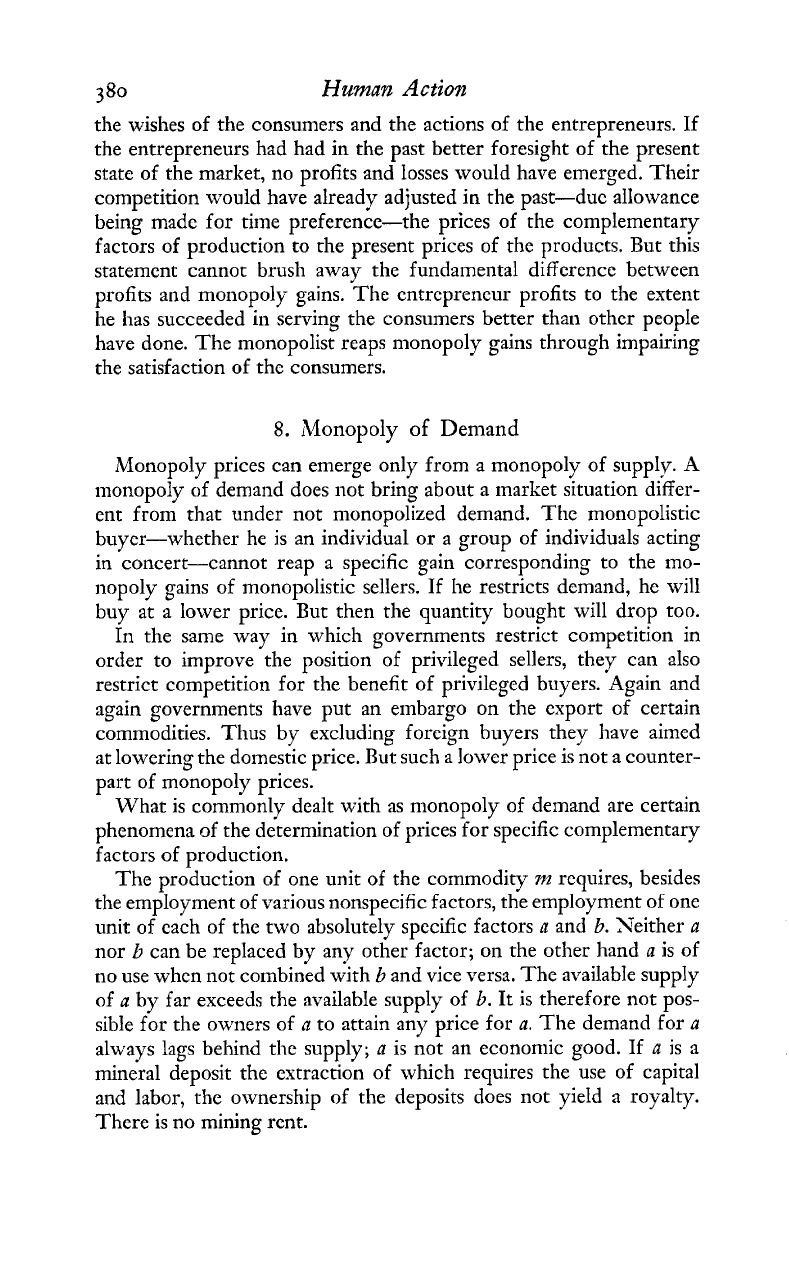
380
Human
Action
the wishes of the consumers and the actions of the entrepreneurs. If
the entrepreneurs had had in the past better foresight of the present
state of the market, no profits and Iosses would have emerged. Their
competition would have already adjusted in the past-duc allowance
being made for time preference-the prices of the complementary
factors of production to the present prices of the products. But this
staterncnt cannot brush away the fundamental diffcrencc bctween
profits and monopoly gains. The cntrcprencur profits to the extent
he has succeeded in serving the consumers better than othcr people
have done. The monopolist reaps monopoly gains through impairing
the satisfaction of thc consumers.
8.
Monopoly
of
Demand
Monopoly prices can emerge only from a monopoly of supply.
A
monopoly of demand does not bring about a ~narket situation differ-
ent from that under not monopolized demand. The monopolistic
buyer-whether he is an individual or a group of individuals acting
in concert-cannot reap
a
specific gain corresponding to the mo-
nopoly gains of monopolistic sellers. If he restricts demand, he will
buy at a lower price. But then the quantity bought will drop too.
In the same way in which governments restrict competition in
order to improve the position of privileged sellers, they can also
restrict competition for the benefit of privileged buyers. Again and
again governments have put an embargo on the export of certain
commodities. Thus by excluding foreign buyers they have aimed
at lowering the domestic price. But such a lower price is not a counter-
part of monopoly prices.
What is commonly dealt with as monopoly of demand are certain
phenomena of the determination of prices for specific complementary
factors of production.
The production of one unit of the commodity
m
requires,
besides
the employment of various nonspecific factors, the employment of one
unit of cach of the two absolutely specific factors
a
and
b.
Neither
a
nor
b
can be replaced by any other factor; on the other hand
a
is of
no use whcn not cotnbined with
b
and vice versa. The available suppIy
of
a
by far exceeds the available supply of
b.
It is therefore not pos-
sible for the owners of
n
to attain any price for
a.
The demand for
a
always lags behind the supply;
a
is not an economic good. If
a
is a
mineral deposit the extraction of which requires the use of capital
and labor, the ownership of the deposits does not yield a royalty.
There is no mining rcnt.
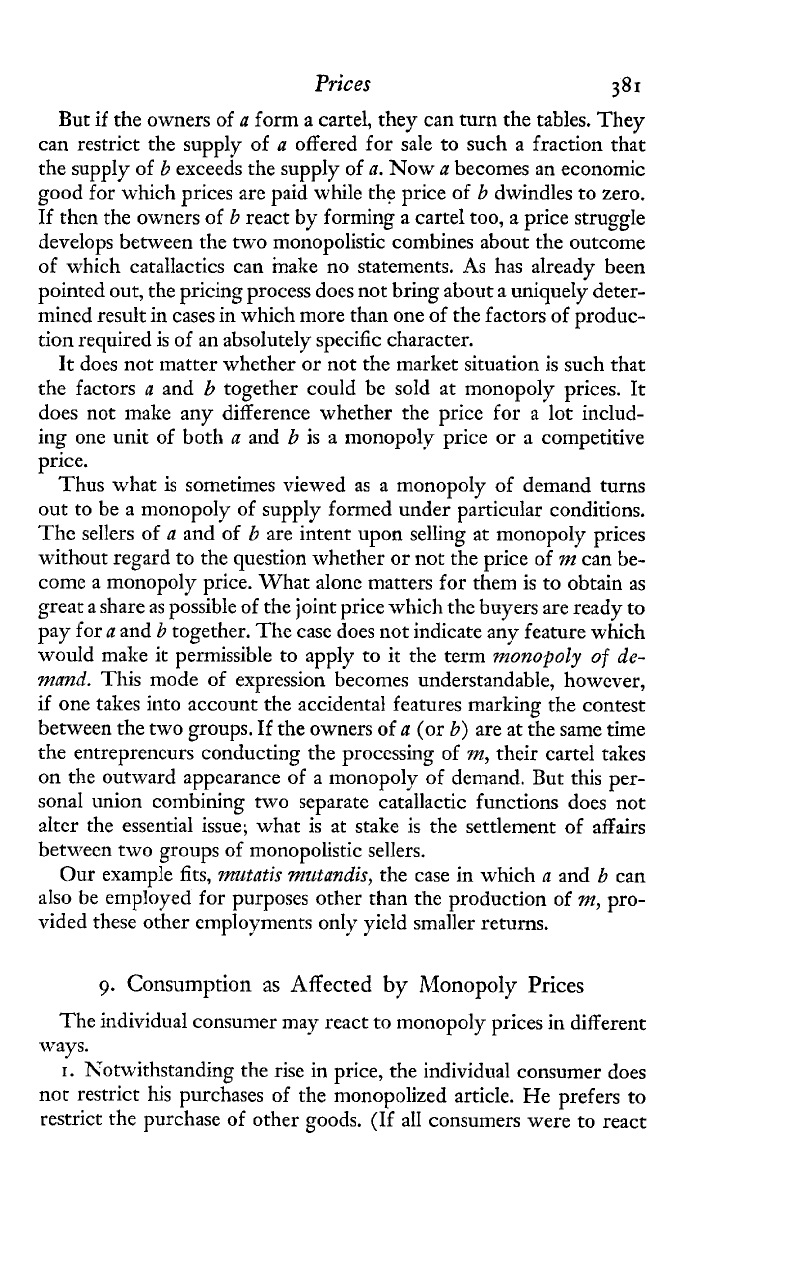
Prices
But if the owners of
a
form a cartel, they can turn the tables. They
can restrict the supply of
a
offered for sale to such a fraction that
the supply of
b
exceeds the supply of
a.
Now
a
becomes an economic
good for which prices are paid while the price of
b
dwindles to zero.
If thcn the owners of
b
react by forming a cartel too,
a
price struggle
develops between the two monopolistic combines about the outcome
of which catallactics can bake no statements. As has already been
pointed out, the pricing process does not bring about
a
uniqueIy deter-
mined result in cases in which more than one of the factors of produc-
tion required is of an absolutely specific character.
It does not matter whether or not the market situation is such that
the factors
a
and
b
together could bc sold at monopoly prices. It
does not make any difference whether the price for a lot includ-
ing one unit of both
a
and
b
is a monopoly price or
a
competitive
price.
Thus what is sometimes viewed as a monopoly of demand turns
out to be a monopoly of supply formed under particular conditions.
Thc sellers of
a
and of
b
are intent upon selling at monopoly prices
without regard to the question whether or not the price of
7n
can be-
come a monopoly price. What alone matters for them is to obtain as
great a share as possible of the joint price which the buyers are ready to
pay for
a
and
b
together. The case does not indicate any feature which
would make it permissible to apply to it the term
monopoly of
de-
mand.
This mode of expression becomes understandable, however,
if one takes into account the accidental features marking the contest
between the two groups. If the owners of
a
(or
b)
are at the same time
the entreprencurs conducting the processing of
m,
their cartel takes
on the outward appearance of
a
monopoly of demand. But this per-
sonal union combining two separate catallactic functions does not
alter the essential issue; what is at stake is the settlement of affairs
between two groups of monopolistic sellers.
Our example fits,
mutatis mutandis,
the case in which
a
and
b
can
aiso be empioyed for purposes other than the production of
nz,
pro-
vided these other employments only yield smaller returns.
9.
Consumption as Affected
by
Monopoly Prices
The individual consumer may react to monopoly prices in different
ways.
I.
h'otwithstanding the rise in price, the individual consumer does
not restrict his purchases of the monopolized article. He prefers to
restrict the purchase of other goods.
(If
all consumers were to react
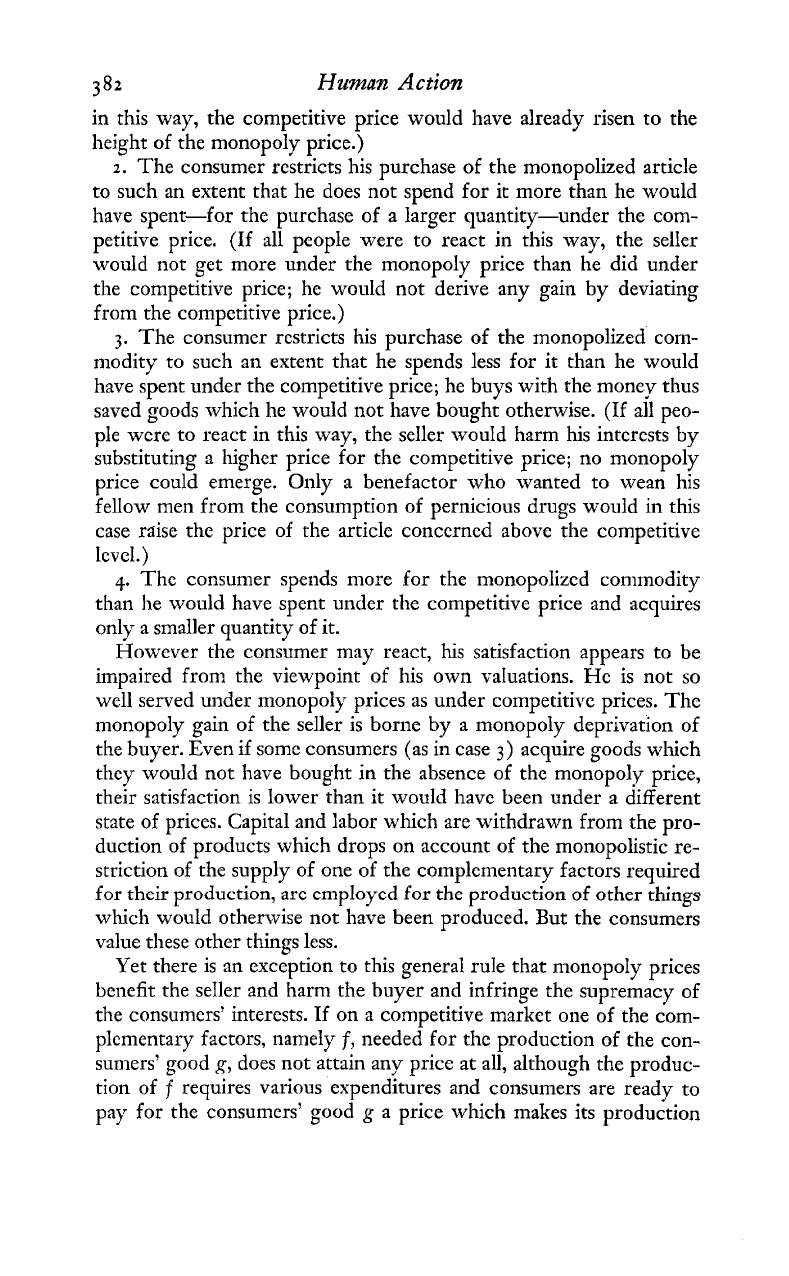
382
Human
Action
in this way, the competitive price would have already risen to the
height of the monopoly price.)
2.
The consumer restricts his purchase of the monopolized article
to such an extent that he does not spend for it more than he would
have spent-for the purchase of a larger quantity-under the com-
petitive price. (If all people were to react in this way, the seller
would not get more under the monopoly price than he did under
the competitive price; he would not derive any gain by deviating
from the competitive price.)
3.
The consumer restricts his purchase of the monopolized com-
modity to such an extent that he spends less for it than he would
have spent under the competitive price; he buys with the money thus
saved goods which he would not have bought otherwise. (If all peo-
ple were to react in this way, the seller would harm his interests by
substituting a higher price for the competitive price; no monopoly
price could emerge. Only a benefactor who wanted to wean his
fellow men from the consumption of pernicious drugs would in this
case raise the price of the article concerned above the competitive
level.)
4. The consumer spends more for the monopolized commodity
than he would have spent under the competitive price and acquires
only a smaller quantity of it.
However the consumer may react, his satisfaction appears to be
impaired from the viewpoint of his own vahations. He is not so
well served under monopoly prices as under competitive prices. The
monopoly gain of the selleE is borne by a monopoly deprivation of
the buyer. Even if some consumers (as in case
3)
acquire goods which
they would not have bought in the absence of the monopoly price,
their satisfaction is lower than it would have been under
a
different
state of prices. Capital and labor which are withdrawn from the pro-
duction of products which drops on account of the monopolistic re-
striction of the supply of one of the complementary factors required
C,"
cL,:,
,",A
..,.
+:,,
A,,
,,,1,,,,2
C,"
*I.,
-..-,a..,.+:--
-C
-cL--
-t:---
1Ul
Ll1G11 ~IUUULLLUlI,
'llL
CLIIpJy
LU
LUI L11G yluUUCLlUl1
Ul
ULIIGI
Llllll
3
which would otherwise not have been produced. But the consumers
value these other things less.
Yet there is an exception to this general rule that monopoly prices
benefit the seller and harm the buyer and infringe the supremacy of
the consumers' interests. If on a competitive market one of the com-
plementary factors, namely
f,
needed for the production of the con-
sumers' good
g,
does not attain any price at all, although the produc-
tion of
f
requires various expenditures and consumers are ready to
pay for the consumers' good
g
a price which makes its production
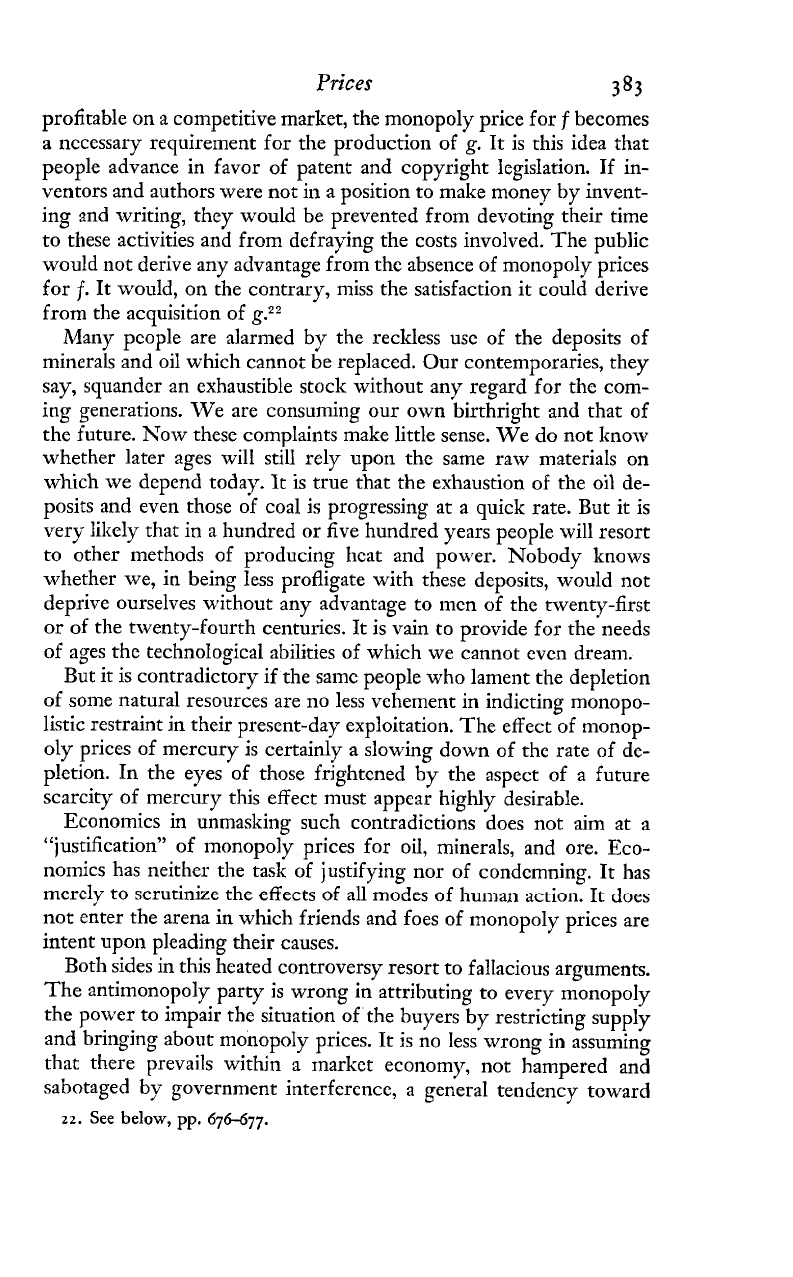
Prices
383
profitable on a competitive market, the monopoly price for
f
becomes
a
ncccssary requirement for the production of
g.
It is this idea that
~eople advance in favor of patent and copyright legislation. If in-
ventors and authors were not in a position to make money by invent-
ing and writing, they would be prevented from devoting their time
to these activities and from defraying the costs involved. The public
would not derive any advantage from the absence of monopoly prices
for
f.
It would, on the contrary, miss the satisfaction it could derive
from the acquisition of
g.Z"
Many pcople are alarmed by the recltless use of the deposits of
minerals and oil which cannot be replaced. Our contemporaries, they
say, squander an exhaustible stock without any regard for the com-
ing generations. We are consuming our own birthright and that of
the future. Now these complaints make little sense. We do not know
whether later ages will still rely upon the same raw materials on
which we depend today. It is true that the exhaustion of the oil de-
posits and even those of coal is progressing at a quick rate. But it is
very likely that in a hundred or five hundred years people will resort
to other methods of producing hcat and power. Nobody knows
whether we, in being less profligate with these deposits, would not
deprive ourselves without any advantage to mcn of the twenty-first
or
of
the twenty-fourth centuries.
It
is vain
to
provide for the'needs
of ages the technoIogica1 abilities of which we cannot even dream.
But it is contradictory if the sainc people who lament the depletion
of some natural resources are no less vehement in indicting monopo-
listic restraint in their present-day exploitation. The effect of monop-
oly prices of mercury is certainly a slowing down of the rate of de-
pletion. In the eyes of those
frightened
by the aspect of a future
scarcity of mercury this effect must appear highly desirable.
Economics in unmasking such contradictions does not aim at a
"justification" of monopoly prices for oil, minerals, and ore. Eco-
nomics has neither the task of justifying nor of condemning. It has
merely to scrutinize the effects of all modes of human action. It does
not enter the arena in which friends and foes of rnonopoly prices are
intent upon pleading their causes.
Both sides in this hcated controversy resort to fallacious arguments.
The antimonopoly party is wrong
in
attributing to every monopoly
the power to impair the situation of the buyers by restricting supply
and bringing about monopoly prices. It is no less wrong in assuming
that there prevails within a market economy, not hampered and
sabotaged by government interference, a general tendency toward
22.
See
below,
pp.
676677.
